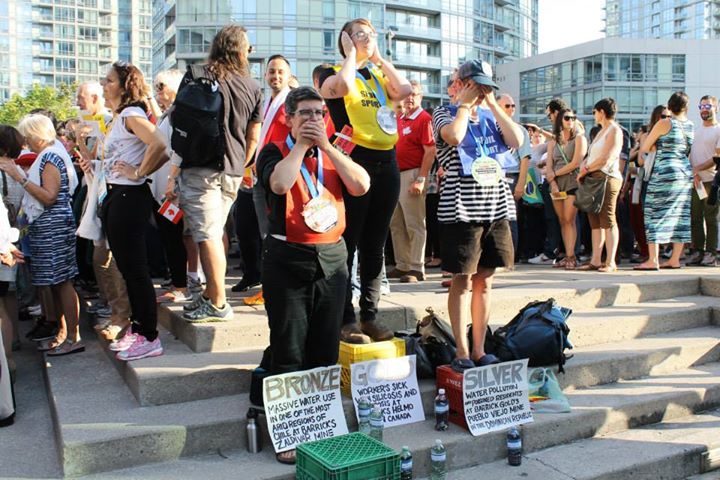Like this article? rabble is reader-supported journalism. Chip in to keep stories like these coming.
When Meaghan Benfeito and Rosaline Filion won gold for Canada in women’s 10-metre synchronized diving, the pair’s smooth pike and entrance into the water mesmerized viewers.
What wasn’t being talked about were the two pieces of hardware each diver had won. One gold apiece for the paired event, another silver for Filion and a bronze for Benfeito from the individual 10-metre dive.
All were provided by Barrick Gold.
According to allegations from mining injustice advocacy groups, these medals are nothing to celebrate.
“The environmental cost of these mines far outweighs these medals’ value to society,” said Sakura Saunders, an activist with the Mining Injustice Solidarity Network and ProtestBarrick.net.
Gold
The gold for the gold medals comes from Hemlo mines in Marathon, Ontario. Workers at these mines report high rates of sickness, Saunder said.
“Workers at the mines have reported numerous cases of lung ailments at these mines, including some cases of silicosis and sarcoidosis,” Saunders wrote in a post for ProtestBarrick.net.
Sylvia Boyce, health and safety coordinator with United Steelworkers, said that mine workers are exposed to an array of health risks on the job.
“Workers that work in the mining industry are exposed to all sorts of occupational hazards that clearly affect their lungs and their body as a whole,” she said. “They can be exposed to all sorts of carcinogens — many have been diagnosed with lung diseases and cancer.”
But Andy Lloyd, senior vice president of communications with Barrick Gold, says workers’ health problems were not his company’s fault.
“The Ministry of Labour investigated these allegations and concluded that claims of silicosis caused by conditions at Hemlo were unfounded,” Lloyd wrote in an email. “The cases in question involved three employees who came to work for Barrick after many years at other mining operations.”
Lloyd said that, due to the latency period of the disease, the Ontario Workplace Safety and Insurance Board concluded the employees’ conditions were a result of conditions at their previous workplaces not those at Hemlo.
Barrick gold sources material for their silver and bronze medals from outside Canada.
Silver
The ore for the silver medals comes from Pueblo Viejo mine in the Dominican Republic. It’s a joint venture between Barrick Gold (60 per cent) and Goldcorp (40 per cent).
This mine, Saunders alleges, has poisoned rivers and killed livestock via cyanide poisoning.
“According to the Latin American Observatory of Environmental Conflicts (OLCA), locals have reported symptoms of cyanide poisoning: skin lesions and ulcers that will not heal, migraines, vision loss, insomnia, severe shortness of breath with purulent sputum (containing pus). Blood tests confirm the presence of heavy metals,” wrote Kelsey Ross, another activist with the MISN, for Now Magazine.
A local farmer, Maria de la Cruz Mariano, whose blood showed high levels of lead, sulphur, cyanide and zinc after testing by a private company was quoted talking about these effects in The Economist.
Lloyd, however, said these allegations are “demonstrably false.”
“The Dominican Ministry of the Environment and the Ministry of Health have both concluded that Pueblo Viejo is not responsible for any water contamination. In fact, Pueblo Viejo has been responsible for cleaning up significant environmental damage left behind by a previous state-run mining company in the area,” he wrote.
Bronze
The copper for the Pan Am bronze medals is sourced from Zaldivan mine in Chile, an open-pit heap-leach mine.
The MISN accuses it of massive water use in the extremely arid Atacama desert. Saunders said the mine used over six billion litres of water in 2013 and that this water use effectively pitted miners against local farmers.
Lloyd has a different story.
“Zaldivar only uses saline (salt) water that is not suitable for human consumption or for agriculture. The mine has no impact on community fresh water supplies,” he wrote.
Saunders still questions why games victories are being celebrated with newly mined metals.
“We should, at the very least, be recycling the medals we use for these things,” she said.
Resistance at the Pan Am Games
This isn’t the first time the Pan Am games have been accused of economic excess.
She said the MISN is planning to resist the Pan Am games using street theatre.
They started with a street theatre workshop at the Toronto Peoples’ Social Forum with a presentation about Barrick Gold’s mines led by Muril Davis and Kate Klein from the MISN.
“The MISN is engaging in a lot of street theatre to fight spectacle with spectacle using sarcasm and play,” said Saunders. “We want to introduce these very real ideas to people that are waiting in line for the Pan Am games.”
A total of 4,283 gold, silver and bronze medals will be awarded in the Pan Am and Parapan Am games.
Megan Devlin is rabble’s news intern for 2015. She hails from Toronto, but she’s starting her Masters in Journalism in Vancouver. She got her start in journalism working at the Western Gazette where she was a news editor for volume 107 and online associate editor for volume 108.
Like this article? rabble is reader-supported journalism. Chip in to keep stories like these coming.




